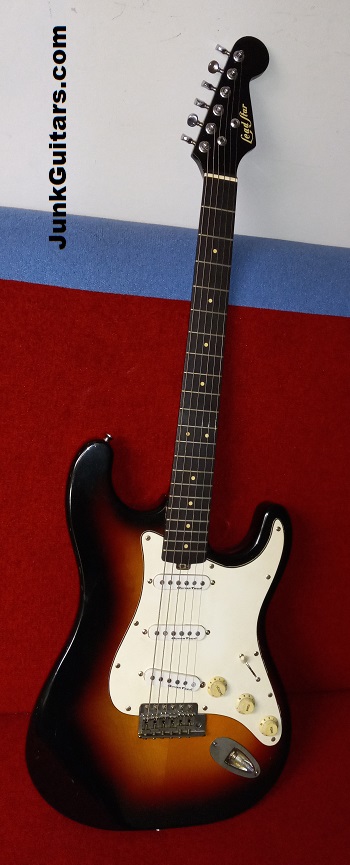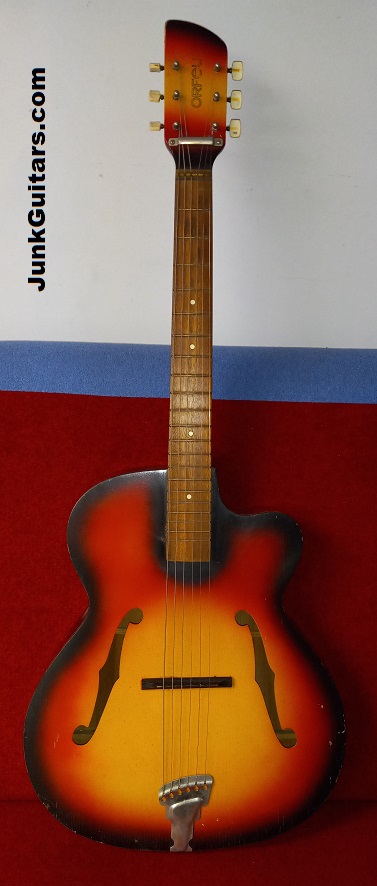
A Primer on Soviet Guitars, Part 1
OK, so you saw some pics of a funky Soviet guitar online and now you want one! There are a bunch of them on eBay and Reverb and acquiring one isn't a problem anymore, like it was twenty years ago. The problem is that everybody says they are unplayable. Are they worth it? They sure look cool...
"Soviet" can be defined narrowly or broadly, meaning either USSR exclusively or the entire Soviet Bloc. In this case, the broader definition is generally used. "Soviet guitars" refers to instruments produced prior to 1991 in USSR, Bulgaria, Czechoslovakia, East Germany, Poland, Yugoslavia, Romania and Hungary. Someone will inevitably point out that these countries are not the same as Russia and have never been part of the Soviet Union. Yes, I am quite aware of that. But these Eastern European countries were all part of the Soviet Bloc at the time. Instruments built within the Soviet Bloc during the Soviet era can be reasonably called Soviet. Like it or not, this umbrella term has been a well-established de facto reality within the hobby for many years now. The point is that a broad range of guitars from various countries is covered. You want a Soviet guitar? Well, what kind? There's a huge difference between an Elta and a Diamant. What are your expectations?
If you expect a guitar that looks bizarre but is otherwise mostly just like a modern one, run away. The rumors are true. You will not be able to play it. The controls will be strange and unfamiliar. It will have high action and will not intonate correctly. It will not be plug-and-play. In fact, you won't even be able to plug it in at all, because your standard guitar cable won't fit. You need to have some skill, knowledge and appreciation for these instruments to get the most out of them, and if that sounds like too much effort, they are not for you. You might be happier with a modern retro-styled guitar, something like an Eastwood reissue. If you insist, a Musima Lead Star is a good first choice. Musima's copy of the Fender Strat will be exotic enough for bragging rights, yet familiar enough for anybody to set up and enjoy.

If you have the right mindset, but are not an intrepid restorer, I will suggest sticking with the more popular Musima and Jolana models or perhaps an Orpheus Hebros or Trimontium bass. Not because a Ural is unplayable or because, say, a Migma Elektra is any worse than a Musima Elektra (it's actually very similar), but simply for practical considerations. You want a model that is reasonably well-known among collectors and not something so exotic that you will never find parts for it, and you want something that can be made functional without a herculean effort. Musima and Jolana guitars are generally of better quality than others of their ilk, and are just that much less fussy and more up to the worldwide standard, while Orpheus hollowbody basses are some of their most successful. Musima and Jolana also use a standard jack, less to worry about there. The Orpheus will need a DIN-to-jack adaptor, which can be found online or fairly easily made if you're handy with a soldering iron. Save the weirder and more restoration-intensive stuff for when you are a little more experienced.
If you are an experienced restorer and aren't afraid to roll up your sleeves, feel free to buy whatever strikes your fancy. You will be filing fret edges, doing a neck reset, messing with the truss rod, figuring out the schematic, replacing rotted binding, gluing loose seams, hunting for parts and undoing half-a-century's worth of abuse and neglect. But you're used to all that, right?
Secondly, let's define "unplayable". Right out of the box as you will receive it? Of course it will be unplayable, unless you have specifically purchased one already restored. After a little TLC? Well... Are you familiar with Japanese guitars of the 1960s? Or European guitars of the same era? Teisco, Framus, that kind of stuff. After a complete overhaul, a Musima or Jolana should play at about the same level as a Framus or similar vintage Western European instrument. After a complete overhaul plus perhaps some additional work to correct all the faults it may have left the factory with, a Tonika or Aelita should function at the level of the average Teisco. If you expect better playability than that, you're being unrealistic. An Orpheus will never be a Gibson. Not even the Orpheus Gibson (yes, that is an actual model name!).
But to some of us, this is good enough, especially when coupled with cool looks, uniqueness, a totally different sonic palette that might be quite useful in the studio, an amazing history and the thrill of discovery and adventure. A Soviet guitar will never replace a professional instrument. And you should always choose a professional instrument to do professional work. But just for fun, they can't be beat.

When choosing your guitar, pay close attention to its condition. Many sellers of Soviet guitars on eBay are simply flippers and know nothing about guitars specifically. They will happily sell you a Kavkaz bass or an old watch or some army uniform, it's all the same to them. Click "See Seller's Other Items" and you will know immediately if you are dealing with this type of seller. Any guitar they list for sale will be in the same condition as when they picked it up at some local flea market, that is, pretty beat up and maybe missing a few parts. Don't blame the seller for selling you junk. It's not their fault, they merely did the legwork and made the guitar available to you. Blame yourself if you looked at the pics and didn't spot problems that should have been obvious. Ask questions. Ask for additional pics. Ask yourself whether you can handle whatever undisclosed problems this instrument might have.
The flippers are bad enough, but there are some reptile dentists out there who unfortunately are far too sure of themselves when it comes to spray paint, power tools and a stash of random old guitar parts. One "vintage shop" on eBay is especially notorious for selling all sorts of Frankenstein monsters quickly thrown together from bits and pieces of old Soviet guitars. These guitars always seem to have only one string on them, just enough to not lose some mismatched, totally wrong, barely-better-than-nothing bridge. Such sellers probably could have put the guitars together correctly, but that would require extra effort and might eat into the profits. Yet some of the guitars these sellers list can be OK - if they were already in decent shape when acquired. Do you know enough to tell the difference? Did you study enough photos of the model that interests you to know how it's supposed to be? Does your spider sense start tingling when something's off? Caveat emptor!
Try to buy from someone who cares about the guitars. There are some great sellers in Russia, Ukraine and elsewhere who will repair an old guitar properly prior to putting it up for sale and are forthcoming about any possible issues. Some are collectors themselves. Seek them out and build a working relationship with them. There are a few such sellers that I have patronized over the years. I know I can trust them and they appreciate repeat business and will sometimes give repeat customers a discount or first pick of new acquisitions. A couple even became good friends.
It is best to hold out for an instrument that's complete. Parts are hard to find and some rarer ones can take years to locate. A guitar priced lower because it is missing hard-to-find parts is not a bargain. Have patience or spend a bit more if you have to.
OK, your guitar has arrived. Now what?
Stay tuned!
© 2003-2023 JunkGuitars.com. All rights reserved.